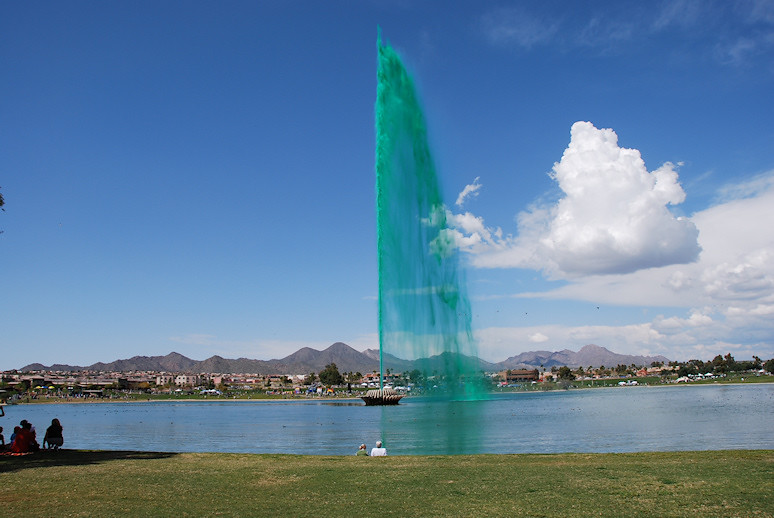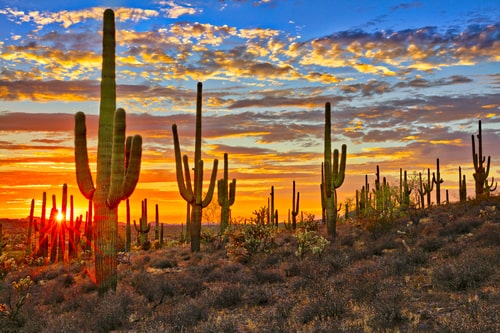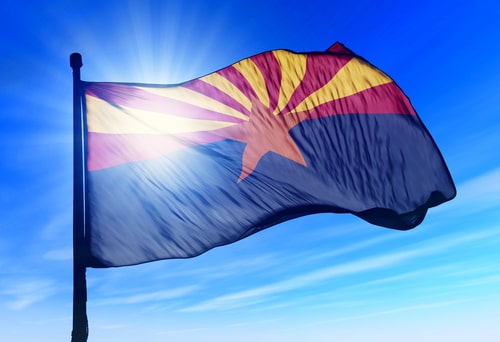Last updated on December 19th, 2023
51. Did you know that the blind adventurers Lonnie Bedwell and Erik Weihenmayer completed a 21-day 277-mile kayak trip through the Grand Canyon on September 28, 2014? A tremendous amount of practice was done by the duo to accomplish the nearly impossible task.
52. Spencer H. Suderman, a certified aerobatics pilot, set the world record for most inverted flat spins in an aircraft at Yuma International Airport in Arizona. He did a total of 98 spins, breaking his own previous record of 81 inverted flat spins.
53. Established in 1991, Sedona’s park covers 286 acres, showcasing stunning red rock formations and diverse plant and animal life. Sedona, known for its breath-taking red rock formations, has become synonymous with UFO sightings and encounters with extra-terrestrial beings. Numerous reported sightings have turned this picturesque town into a hub for enthusiasts of the unexplained.

54. Fountain Hills, Arizona, is home to one of the world’s tallest fountains, soaring up to 560 feet (170 meters). This impressive water feature adds elegance to the town’s scenery and captivates visitors with its grandeur.
55. Arizona is home to the Petrified Forest National Park, which contains one of the world’s largest and most colorful concentrations of petrified wood. With its rich colors and unique geological formations, the park offers a captivating glimpse into Earth’s prehistoric past, attracting visitors worldwide.
56. Established in 1908, Tumacácori National Historical Park in Arizona showcases the ruins of three Spanish mission communities. Visitors can explore these ancient sites, gaining insights into the area’s rich cultural and religious history.
57. The Superstition Mountains in Arizona hold an enduring mystery, with legends suggesting the presence of a hidden gold mine belonging to the elusive “Lost Dutchman.” This enigmatic tale has intrigued treasure hunters and adventurers for generations.
58. Piestewa Peak, once Squaw Peak, was renamed in honor of Lori Piestewa, the first Native American woman to die in U.S. military combat. It stands as a symbol of her bravery and sacrifice, reminding all of her enduring legacy.
59. Arizona boasts a rich tapestry of Native American heritage, hosting 22 tribes within its borders. Among them are the esteemed Navajo, Hopi, and Apache nations, each preserving their unique cultures and traditions, enriching the state’s diverse cultural landscape.
60. Canyon de Chelly in northeastern Arizona spans 83,840 acres and is entirely owned by the Navajo Tribal Trust of the Navajo Nation. Rich in history, it features ancient ruins and petroglyphs. The largest Native American Reservation – the Navajo Nation — is found in Arizona. It reserves an area of 17,544,500 acres.
61. The Apache Trail, winding its way through the majestic Sonoran Desert, is not just a highway but a visual feast for nature enthusiasts. Its picturesque route is defined by sweeping vistas, dramatic cliffs, and captivating landscapes, making it a must-visit destination for anyone seeking the raw beauty of Arizona’s wilderness.
62. Havasu Falls, nestled in the Grand Canyon, allures over 30,000 visitors yearly with its stunning turquoise-blue waters contrasting against the surrounding red cliffs. A cherished spot for adventurers, it offers a unique blend of natural beauty and thrilling hiking experiences.
63. The Wave, located in the Coyote Buttes area of Paria Canyon-Vermilion Cliffs Wilderness, is a mesmerizing sandstone formation spanning just a few acres. Its vivid hues and intricate patterns, shaped by nature over millions of years, attract global travelers and photographers.
64. Arizona’s captivating desert landscapes have been the backdrop for numerous iconic Hollywood Westerns, including classics like “Stagecoach” and “Tombstone.”
65. Rooster Cogburn’s Ostrich Ranch in Picacho invites visitors to interact with ostriches, offering a unique and memorable experience. Spanning 600 acres, the ranch provides a close encounter with these magnificent birds.
66. In 1968, the original London Bridge, facing replacement, was bought by Robert P. McCulloch and relocated to Lake Havasu City, Arizona. Carefully dismantled and reconstructed, it now spans Lake Havasu, a surprising historical gem in the Arizona desert.
67. In Bisbee, Arizona, Cardiac Hill, a staircase with 1,000 steps, was used by miners to climb from their underground workplaces. This historic landmark symbolizes the miners’ endurance and is a heart-breaking reminder of Bisbee’s rich mining heritage.
68. Arcosanti, located in Arizona, is an experimental town designed by architect Paolo Soleri to house 5,000 people sustainably under one roof. This visionary project emphasizes eco-friendly architecture and communal living, showcasing a prototype for future urban sustainability.
69. Three years before the Civil Rights Act was passed in 1968, the African American couple of Carol and Warren Livingstone had purchased property in Tempe, Arizona. This speaks volumes about the established culture: easygoing, friendly and quiet. And as if that wasn’t enough, the comedy rock band Pyschostick is originally from Tempe.
70. Arizona has numerous 19th-century ghost towns, remnants of old mining communities. These abandoned sites offer a captivating glimpse into the state’s frontier history, preserving the stories of pioneers and miners from the past.
71. Opened in 1952, the Arizona-Sonora Desert Museum in Tucson stands as a testament to the captivating biodiversity of the Sonoran Desert. Visitors can explore its exhibits, which educate about the diverse flora and fauna and highlight the desert’s unique ecosystems and the importance of conservation.
72. Opened in 2009 by Patricia and Walter Arnell, the Mini Time Machine Museum of Miniatures in Tucson is one of the world’s smallest yet most captivating museums. Its intricate exhibits, showcasing meticulous miniature creations, offer visitors a delightful journey through time and imagination.
73. Visit Phoenix in summer and you’ll know why the NBA team Phoenix Suns was aptly named, as Phoenix, is popularly known as the valley of the sun, for obvious reasons. Located in a desert, this is something of a miracle city as you’d least expect it to be the fifth most populous city in the United States. With the famous Colorado River running through it, Mexico a stone throw away, and the first McDonald’s franchise being sold to a local Neil Fox, Phoenix is quite a unique city.
74. Phoenix, Arizona ranks consistently number one for the most days a year when the temperature rises above 89 degrees Fahrenheit or 99 degrees Fahrenheit. The city sees sunshine more than 105 days a year when the temperature is above 99 degrees Fahrenheit.
75. In terms of population, Mesa has by far the largest suburban population in the United States, outnumbering well-known cities like Miami and Minneapolis. Renowned for having hot summers and mild winters, it is a prime tourist destination for people from colder regions of the country. Mesa is home to Buck Owens (inductee to the Country Music Hall Of Fame), Misty Hayman (Olympic gold medallist and hitherto world record holder) and Tyson Apostol (winner of the 2009 edition of reality TV show Survivor).
76. During Arizona’s monsoon season, the state frequently experiences haboobs , massive dust storms causing reduced visibility and potential damage. The largest haboob in recent history occurred in July 2011.
77. On the strength of a 2019 national survey, Gilbert, Arizona, was rated as the 4th safest place to live and the 7th best place to raise a family. A happy medium in terms of climate, you find that it brings together subtropical, tropical and desert climates, making it a rare find as far as desert weather is concerned.
78. Chandler, named after Alexander John Chandler -a 19th century surgeon- this is a city whose establishment is like no other. Notable attractions include its annual Ostrich Festival, an occasion of wearing hats with colourful and vibrant feather plumes, and a tradition that has spread to all the ends of the world. Chandler experienced rapid population growth in the 1990’s, making it one of the fastest growing municipalities in the country.
79. If you thought you had Arizona figured out, you don’t know the half of it. Far from being mildly picturesque, the mountains and hills of Twin Buttes, Sunrise Mountain, Cholla Mountain-to name but a few-are perhaps the main reason why Peoria was ranked among the top 100 places to live by Money Magazine.
80. Arizona is home to uniquely named towns like Why, Bagdad, and Nothing, each offering a quirky charm to travelers.
81. The Davis-Monthan Airforce Boneyard in Tucson boasts of being the world’s largest airplane boneyard. It has served as a storage site for military airplanes from World War 2 to date. The area experiences low humidity and low rainfall, along with having hard alkaline soil and being situated 2,550 feet in altitude. This allows the natural preservation of the aircraft for possible reuse.
82. The Scottsdale Fashion Square Mall is one of the largest shopping malls in the entire country. Considered as the most western part of the west, Scottsdale has a humble, adorable aura about it, albeit, with a sprinkle of the sophisticated old-fashioned stores, art galleries and teaming with streets, you’re bound to get lost at some point. But you’ll be caught unaware when you walk into the Scottsdale Fashion Square Mall, now how about that for some aggressive simplicity.
83. The Mojave Desert is the driest desert in the northern hemisphere with average annual precipitation ranging between 3.5 inches at lower elevations to nearly 10 inches in the mountains. The Mojave desert or the High Desert occupies the northwestern part of Arizona. It is named after the Mohave tribe. The vegetation mainly comprises short shrubs though a variety of seasonal plants blossom during the rainy winter months. The most conspicuous tree species is the iconic Joshua tree that forms extensive forests at high elevation.

84. The Sonora is unique in that it is the only place where the majestic and impressive saguaro cactus grows. The saguaro blossom is the official flower of Arizona and blooms in the summer months of May and June.
85. The Sonora is not only one of the hottest deserts in North America but also has the most bio-diversity due to the bimodal rain patterns affecting winter and spring months. With an area of around 260,000 square kilometers, the Sonoran desert covers most southern Arizona and extends to California and Sonora State in Mexico. Sonora hosts both Santa Catalina and Kofa Mountains, but only Catalina has snow. Sonora has high precipitation for a desert averaging at 10 inches of rainfall annually. Desert is any region on Earth that has a moisture deficit over the course of a year, meaning they can have less rainfall in a year than they give up through evaporation. Deserts actually make up 33%, or 1/3rd of the Earth’s total landmass.
86. The Great basin is a cold desert in northern Arizona characterized by sparse vegetation comprising mostly of sagebrush, prickly cactus, and junipers. It hosts the southern rim of the Grand Canyon with breath-taking gorges carved by erosion over millions of years. The great basin is famous for the legendary Bristlecone Pines. These trees have endured for millennia, with some having an estimated age of 5,000 years. Visitors should watch out for a diverse range of seasonal plants that bloom in the late summer.
87. Since its inception in 1955, the Tucson Gem and Mineral Show have hosted one of the world’s largest gem and mineral shows annually. This vibrant event attracts enthusiasts and experts globally, showcasing a stunning array of gems, minerals, and fossils.
Five facts about the flag of Arizona
1. The state flag of Arizona was designed in 1917 by Charles Harris of the state’s National Guard. The state’s legislature officially adopted the flag that same year, despite the governor, Thomas Campbell refusing to sign the bill and refusing to explain why.

2. A 2001 survey by the Vexillological Association, a society devoted to flags, voted Arizona’s flag as the 6th best in the US. Other surveys routinely show it to be one of the ten best designed and best liked flag designs in the country. Earlier versions of the flag resembled the Japanese flag too much, and were criticized for that reason.
3. The yellow and red stripes on the top half of the flag symbolize the unique and spectacular landscape of Arizona, as well as suggesting the sun rising or setting. More copper is produced in Arizona than in any other state, as signified by the gold colored star in the center of the flag. The copper color was supposedly created by mixing copper dye in hot water.
4. The distinctive gold and red colors on the flag were also those that were favored by the Spanish explorer Francisco Coronado during the 16th century. Coronado and his party explored much of Arizona and were the first Europeans to see the Colorado River and the Grand Canyon.
5. The official measurements of the state’s flag were intended to be six feet wide, and four feet high. The red and yellow area at the top, and the blue area at the bottom were designed to be exactly the same size, with the five pointed star at the very center. The blue and red colors used on the Arizona state flag are the same colors as are traditionally used in the United States national flag.
Arizona – Quick Facts and State Symbols
| State Abbreviation | AZ |
|---|---|
| State Capital | Phoenix |
| Largest City | Phoenix |
| State Size | Total (Land + Water): 113,998 sq miles; Land Only: 113,635 sq miles |
| Geographic center | Yavapai, 55 miles ESE of Prescott |
| Population | 7,582,384 (Estimate July 1, 2024 from United States Census Bureau) |
| Statehood | February 14, 1912 |
| State rank by population | 14th |
| State rank by date of formation | 48th |
| State rank by area | 6th |
| Number of Counties | 15 Complete list of 50 states and number of counties in each |
| Demonym | Arizonan |
| Bordering States | California, Colorado, Nevada, New Mexico, Utah |
| Official Language | English |
| Highest Point | Humphreys Peak 12,637 ft (3852 m) |
| Lowest point | Colorado River at the Sonora border 72 ft (22 m) |
| Mean elevation | 4,100 feet above sea level |
| Length | 400 miles (645 km) |
| Width | 310 miles (500 km) |
| National Parks | Grand Canyon National Park Petrified Forest National Park Saguaro National Park |
| Governor | Katie Hobbs (D) |
| Secretary of State | Adrian Fontes (D) |
| Electoral Votes | 11 |
| State Motto | Ditat Deus (God enriches) |
| State Nickname | The Grand Canyon State |
| % Water | 0.35 |
| Nobel Prize Winners | Roy J. Glauber (Nobel Prize in Physics 2005) Nicolaas Bloembergen (Nobel Prize in Physics 1981) Willis E. Lamb, Jr. (Nobel Prize in Physics 1955) |
| Famous People | Curley Culp (Pro Football Player) Wes Bentley (Actor) Jordin Sparks (Singer) |
| State Fish | Apache Trout |
| State Bird | Cactus Wren |
| State Gemstone | Turquoise |
| State Reptile | Arizona ridge-nosed rattlesnake |
| Endemic mammal | Ringtail |
| State Flower | Saguaro Cactus Blossom |
| State Fossil | Petrified wood |
| State Butterfly | Two-tailed Swallowtail Butterfly |
| State Tree | Blue Palo Verde |
| State Firearm | Colt Single Action Army Revolver |
| State Amphibian | Arizona tree frog |
| Longitude | 109° 03′ W to 114° 49′ W |
| Latitude | 31° 20′ N to 37° N |
| Time Zone | Mountain Time Zone |
| Website | www.az.gov |
| Area Codes | 480, 520, 602, 623, 928 |
| Table last updated | May 10, 2025 |
